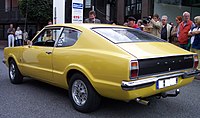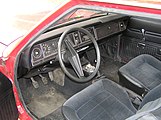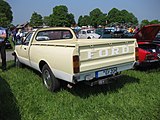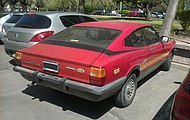Ford Taunus TC
The Ford Taunus TC is a mid-range car from Ford that was built from autumn 1970 to summer 1982. It was offered with four-cylinder in- line engines or six-cylinder V-engines and had rear-wheel drive . It is the successor to the Ford P6 , which were technically different with front-wheel drive and V4 engines. The British Ford Cortina MK III was built on the same platform and from 1976 was identical (hence the name "TC" = Taunus Cortina).
The nickname "Knudsen-Taunus" of the model until the end of 1975 comes from Semon E. "Bunkie" Knudsen . From the beginning of 1968 to autumn 1969 he was Ford's CEO and under him new models were given a characteristic protrusion in the radiator grille and on the bonnet (so-called Knudsen nose ).
In the late summer of 1982 the Taunus was replaced by the Ford Sierra , which had been redesigned except for the engines .
Model history
The smaller types had new four-cylinder in-line engines with overhead camshaft (OHC) that had been developed from the engine of the American Ford Pinto . The six-cylinder V-engines from the earlier P5 and P7 series, built in Cologne, were reserved for the top models. From a displacement of 1.6 liters, a three-speed automatic transmission could also be ordered instead of the standard manual four-speed gearbox. Like the earlier Ford P6 and P7 models, the TC had a rigid axle at the rear, but no longer on leaf springs, but on two longitudinal and trailing arms and coil springs. The new Taunus also had a safety steering column, as has long been the case with its competitors.
The Taunus was offered as a two- and four-door notchback sedan . From the first TC series, which was built from 1970 to 1975, there was also a two-door fastback coupé. A station wagon , traditionally called “tournament” at Ford, was also available. The equipment variants and names varied depending on the construction period: The N (standard), L, XL, GXL and GT of the first TC series became N, L, GL, S and Ghia in the second. From September 1979 (TC '80) the equipment variant S was converted into the S package; the equipment variant L then became an LS, the GL became the GLS and the Ghia became the Ghia S.
The Taunus and Cortina of the first TC series differ from each other externally (pronounced hip swing on the Cortina, thicker beads on the hood of the Taunus) and by the engines. From model year '76 onwards, the exterior was the same.
While the first "Knudsen-Taunus" still clearly stands out from its smoothed successors, the two last model series TC '76 and TC '80 differ mainly in the front section (modified radiator grille on the TC '80 with large plastic slats and drawn around the edges Indicators), the rear (the TC '80 has wider taillights than the TC '76) and in the proportions of the body: the TC '80 has a higher passenger cell than the TC '76.
Model overview
TC '71 (September 1970 to August 1973)
The first Taunus TC was presented in September 1970 (model year 1971, hence '71). Five equipment variants were available: Standard, L, the luxuriously touched XL, the sporty GT and, as the top model, the GXL. All variants were available as a two- or four-door sedan. The station wagon was only available as standard; L or XL and the coupe was not available in the standard version.
Standard, L (equipped with round headlights as standard, which should set them apart from the better models) and XL (angular headlights) were equipped with a 1300 cm³ OHC LC four-cylinder (LC: low compression) as standard 55 HP made, as HC with high compression it made 4 HP more, thus 59 HP. On request, there was also a 1600 cc OHC HC (HC - high compression) engine of the same design with 72 hp (later also available with lower compression and 68 hp). The GT and GXL were also equipped with a 1600 cc OHC HC engine as standard, which (due to a manifold and a Weber carburetor) made 88 hp. They had a more sporty, tuned chassis and a more powerful braking system with larger drum brakes on the rear axle and were equipped with extras such as B. a compartment in the center console, foamed sports steering wheel, round additional halogen lights and additional instruments (rev counter, ammeter, oil pressure gauge) etc.
On request, a two-liter V6 engine with 90 hp was also available for the Taunus GT and GXL, which was already known from the 20M models of the 1960s (the so-called "Cologne V6" of the P5 series ). At the end of 1971, the new top-of-the-range engine was a 2.3-liter V6 engine (as in the 20M of the previous P7 series ), which was identical in design to the two-liter and with its 108 hp drove the Taunus to an impressive 175 km / h at the time accelerated. Because of quality defects in the first time after the start of series production, the Taunus was awarded the "Silver Lemon" - the price for serious new car defects - from the ADAC . The car testers also complained about the overall spongy, uncomfortable chassis and the confusing dashboard, which is similar to that of the 1969 Ford Mustang . In addition, in all Taunus the window cranks were fastened in the upper half of the door panel, while the door openers were fastened far below.
- Engines
- 1.3 l, 55 PS (40 kW), OHC (four-cylinder in-line engine)
- 1.6 l, 68 PS (50 kW), OHC (four-cylinder in-line engine)
- 1.6 l, 72 PS (53 kW), OHC (four-cylinder in-line engine)
- 1.6 l, 88 PS (65 kW), OHC (four-cylinder in-line engine)
- 2.0 l, 90 PS (66 kW), V6 (six-cylinder V-engine)
- 2.3 l, 108 PS (79 kW), V6 (six-cylinder V-engine)
TC '74 (September 1973 to December 1974)
In the summer of 1973, the Taunus was redesigned according to the criticisms of the press: the dashboard became more sober and functional (and was retained in this form in the Taunus '76); the chassis was retuned and equipped with front and rear stabilizers as standard, which improved the handling a little.
Outwardly little changed: all models now had a uniform dark gray plastic grille with square headlights, but Standard and L no longer had a crest in the middle of the radiator, but only the Ford logo on the bonnet. The GT equipment variant was omitted, instead the XL received a rev counter and, on request, the 2-liter V6 engine. The top model GXL got a black flank protection with wider trims and a dashboard and door panels with real wood veneer.
- Engines
- 1.3 l, 55 PS (40 kW), OHC (four-cylinder in-line engine)
- 1.6 l, 72 PS (53 kW), OHC (four-cylinder in-line engine)
- 1.6 l, 88 PS (65 kW), OHC (four-cylinder in-line engine)
- 2.0 l, 90 PS (66 kW), V6 (six-cylinder V-engine)
- 2.3 l, 108 PS (79 kW), V6 (six-cylinder V-engine)
TC '75 (January 1975 to December 1975)
In early 1975 the Taunus was revised again.
In the simple Standard and L models, the moldings around the windows were now matt black, the crowned coats of arms with the cubic capacity on the front fenders gave way to numbers and the Ford coat of arms on the radiator grille and the lettering on the bonnet were now replaced by a simple " Ford ”lettering on the driver's side of the radiator grille replaced. The Ford lettering on the tailgate, which previously took up the entire width of the Standard and L and was designed as a wide aluminum strip on the XL and GXL, moved in a smaller form to the upper left corner of the trunk lid, which became the Taunus lettering instead of the previous one in curved cursive, now in simple block letters. The station wagon, which was now called "Freizeit-Taunus" instead of the tournament, was also available with GXL equipment.
At the turn of the year 1975/1976, the new model was presented, which was smooth on the outside, but technically still had a lot in common with the TC of the first series: the Taunus TC '76.
Engines:
- 1.3 l, 55 PS (40 kW), OHC (four-cylinder in-line engine)
- 1.6 l, 68 PS (50 kW), OHC (four-cylinder in-line engine)
- 1.6 l, 72 PS (53 kW), OHC (four-cylinder in-line engine)
- 1.6 l, 88 PS (65 kW), OHC (four-cylinder in-line engine)
- 2.0 l, 90 PS (66 kW), V6 (six-cylinder V-engine)
- 2.3 l, 108 PS (79 kW), V6 (six-cylinder V-engine)
| Technical data Ford Taunus (1970–1975) | ||||||||||||
|---|---|---|---|---|---|---|---|---|---|---|---|---|
| Ford Taunus: | 1300 (1970-1975) | 1300 S (1973–1974) | 1600 (1974-1975) | 1600 S (1970-1975) | 1600 GT (1970-1975) | 2000 S (1970-1975) | 2300 S (1970-1975) | |||||
| Engine: | 4-cylinder in-line engine (four-stroke) | 6-cylinder V-engine (four-stroke; cylinder angle 60 °) | ||||||||||
| Displacement: | 1294 cc | 1593 cc | 1999 cc | 2294 cc | ||||||||
| Bore × stroke: | 79 mm × 66 mm | 87.65 mm × 66 mm | 84 mm x 60.14 mm | 90 mm x 60.14 mm | ||||||||
| Performance at 1 / min: | 40 kW (55 PS) at 5500 |
44 kW (59 PS) at 5500 |
50 kW (68 hp) at 5500 |
53 kW (72 PS) at 5500 |
65 kW (88 PS) at 5700 |
66 kW (90 PS) at 5000 |
80 kW (108 hp) at 5000 |
|||||
| Max. Torque at 1 / min: | 90 Nm at 3000 | 97 Nm at 3000 | 113 Nm at 2800 | 118 Nm at 2700 | 124 Nm at 4000 | 149 Nm at 3000 | 176 Nm at 3000 | |||||
| Mixture preparation: | 1 downdraft carburetor (Ford) | 1 register downdraft carburetor (Ford) | 2 double downdraft carburetors (Solex) | |||||||||
| Valve control: | OHC , timing belt | central camshaft, spur gears | ||||||||||
| Cooling: | Water cooling | |||||||||||
| Transmission: | 4-speed gearbox a.W. (except 1300 / 1300S) three-stage automatic ( BorgWarner ) |
|||||||||||
| Front suspension: | Independent suspension on double wishbones , coil springs (from September 1973 with anti-roll bar) | |||||||||||
| Rear suspension: | Rigid axle , longitudinal and trailing arms, coil springs (from September 1973 with anti-roll bar) | |||||||||||
| Brakes: | Front disc brakes (Ø 247.7 mm), rear drum brakes (Ø 203.2 mm) | Front disc brakes (Ø 247.7 mm), rear drum brakes (Ø 228.6 mm) | ||||||||||
| Steering: | Rack and pinion steering | |||||||||||
| Body: | Sheet steel, self-supporting | |||||||||||
| Track width front / rear: | 1422/1422 mm | |||||||||||
| Wheelbase: | 2578 mm | |||||||||||
| Length: | 4267 mm (tournament: 4369) | |||||||||||
| Empty weight: | 1005-1140 kg | |||||||||||
| Top speed: | 135 km / h | 138 km / h | 140-145 km / h | 143-148 km / h | 158-163 km / h | 157-162 km / h | 168-173 km / h | |||||
| 0-100 km / h: | 23-24 p | 21-22 p | 16.5-19.5 s | 16-19 p | 14-17 p | 14-17 p | 11.5-13.5 s | |||||
| Consumption (liters / 100 kilometers): | 11.5-12.0 N | 10.5-11.0 S | 13-13.5 N | 12.0-12.5 S. | 12.5-13.5 S. | 14.0-15.0 S | 14.0-15.0 S | |||||
TC '76 (January 1976 to August 1979)
In early 1976 the Taunus was revised again. The “Knudsen nose” fell away and the car got a simpler look overall. In the interior, new steering wheels were added to the dashboard of the predecessor. From this point on, Taunus and Cortina were completely identical.
The equipment designations were also changed: In addition to the Basis and L, there was now the GL instead of the XL; the GXL became the Ghia. Sports-oriented buyers could also choose the Taunus S. Only this was available with the 98 hp four-cylinder (108 hp V6 as an option).
The coupé was withdrawn from the market, so that the customer could only choose between two- and four-door sedans and the five-door tournament. But this was not available as S or Ghia.
- Engines
- 1.3 l, 55 PS (40 kW), OHC (four-cylinder in-line engine)
- 1.6 l, 68 PS (50 kW), OHC (four-cylinder in-line engine)
- 1.6 l, 72 PS (53 kW), OHC (four-cylinder in-line engine)
- 1.6 l, 88 PS (65 kW), OHC (four-cylinder in-line engine)
- 2.0 l, 90 PS (66 kW), V6 (six-cylinder V-engine)
- 2.3 l, 108 PS (79 kW), V6 (six-cylinder V-engine)
TC '80 (September 1979 to June 1982)
Although there are many similarities to the Taunus '76, almost all the visible sheet metal parts had been changed. The '80 model year has higher windows due to the changed roof line. Furthermore, larger indicators drawn around the fenders , a louvred radiator grille , wider rear lights , bumpers with plastic corners and another front apron are installed at the front . The equipment variant S was omitted. Instead, an S package was available for L, GL and Ghia.
The Taunus '80 with the 2.0 V6 engine was manufactured for the Turkish market by the Otosan company near Izmir until the mid-1990s.
Ford Taunus as a pickup
- Engines
- 1.3 l, 43 kW (59 PS), OHC (four-cylinder in-line engine)
- 1.6 l, 51 kW (70 PS), OHC (four-cylinder in-line engine)
- 1.6 l, 54 kW (73 PS), OHC (four-cylinder in-line engine)
- 1.6 l, 66 kW (90 PS), OHC (four-cylinder in-line engine) (only available in combination with S-package)
- 2.0 l, 75 kW (101 PS), OHC (four-cylinder in-line engine)
- 2.0 l, 66 kW (90 PS), V6 (six-cylinder V-engine)
- 2.3 l, 84 kW (114 PS), V6 (six-cylinder V-engine)
Special models
Special models in limited editions were offered, among others, the following versions:
- Taunus Cologne (1978)
- Taunus Festival (1980)
- Taunus Favorite (1981)
- Taunus Brillant (1982)
- Cortina Carousel (Great Britain) with two-tone paintwork
- Cortina Crusader (Great Britain) with two-tone paintwork
| Technical data Ford Taunus (1976–1982) | ||||||||||||
|---|---|---|---|---|---|---|---|---|---|---|---|---|
| Ford Taunus: | 1300 (1976-1982) | 1600 (1976-1982) | 1600 S (1976-1982) | 2000 S (1976-1982) | 2000 V6 (1976–1982) | 2300 V6 (1976-1982) | ||||||
| Engine: | 4-cylinder in-line engine (four-stroke) | 6-cylinder V-engine (four-stroke; cylinder angle 60 °) | ||||||||||
| Displacement: | 1294 cc | 1593 cc | 1993 cc | 1999 cc | 2294 cc | |||||||
| Bore × stroke: | 79 mm × 66 mm | 87.65 mm × 66 mm | 90.8 mm × 77 mm | 84 mm x 60.14 mm | 90 mm x 60.14 mm | |||||||
| Performance at 1 / min: | 40 kW (55 PS) at 5500 |
50 kW (68 hp) at 5200 |
53 kW (72 PS) at 5000 |
72 kW (98 PS) at 5200 |
66 kW (90 PS) at 5000 |
80 kW (114 hp) at 5000 |
||||||
| Max. Torque at 1 / min: | 88 Nm at 3000 | 113 Nm at 2700 | 116 Nm at 2700 | 148 Nm at 3500 | 146 Nm at 3000 | 173 Nm at 3000 | ||||||
| Mixture preparation: | 1 downdraft carburetor (Ford) | 1 register carburetor (Weber) | 1 double carburetor (Solex) | |||||||||
| Valve control: | OHC , timing belt | central camshaft, spur gears | ||||||||||
| Cooling: | Water cooling | |||||||||||
| Transmission: | 4-speed gearbox a.W. (except 1300) three-stage automatic (Ford C3) |
|||||||||||
| Front suspension: | Independent suspension on double wishbones , coil springs with anti-roll bar | |||||||||||
| Rear suspension: | Rigid axle, longitudinal and trailing arms, coil springs with anti-roll bar | |||||||||||
| Brakes: | Front disc brakes (Ø 247.5 mm), rear drum brakes (Ø 203.2 mm) | Front disc brakes (Ø 247.5 mm), rear drum brakes (Ø 228.6 mm) | ||||||||||
| Steering: | Rack and pinion steering | |||||||||||
| Body: | Sheet steel, self-supporting | |||||||||||
| Track width front / rear: | 1422/1422 mm | |||||||||||
| Wheelbase: | 2579 mm | |||||||||||
| Length: | 4340–4380 mm (tournament: 4440–4480 mm) | |||||||||||
| Empty weight: | 1020-1195 kg | |||||||||||
| Top speed: | 137 km / h | 142-147 km / h | 147–152 km / h | 162-167 km / h | 158-163 km / h | 168-173 km / h | ||||||
| 0-100 km / h: | 23.5 s | 16.5-19.5 s | 16-19 p | 12.5-14.5 s | 14.5-16.5 s | 12-13.5 s | ||||||
| Consumption (liters / 100 kilometers): | 11.5-12.0 N | 13.0-13.5 N | 12.0-12.5 S. | 13.5 S. | 13.5 S. | 14.0 p | ||||||
successor
The direct successor to the Ford Taunus with a new body shape and improved chassis is the Ford Sierra , which appeared in September 1982 . This was initially only offered as a hatchback sedan and station wagon, while the classic notchback model was only included in the range with a model change in early 1987.
After the cessation of the Taunus in Cologne and Genk, the production facilities were brought to Argentina and Turkey. Ford Argentina also brought out the Taunus '80 as a coupé - a body variant of this model that was never available in Europe.
The Turkish license building of the Otosan company, on the other hand, was modernized with a lot of plastic and adapted to the tastes of car buyers. This "Taunus IV" was also equipped with the dashboard of the first Sierra generation. Otosan built the Taunus in this form until 1994.
The Taunus in Argentina
From July 1974 to 1985, the Taunus was also produced in Argentina as a four-door sedan with a two-liter or 2.3-liter four-cylinder engine (93-134 SAE PS / 68-99 kW) and as a coupé (only 2.3 liters). In 1981 there was a facelift, similar to the German Taunus '80, which the coupé also took part. The sedans were available in the L and GXL versions, from 1981 as the L, Ghia and Ghia S, the coupé as a GT and from 1983 in the sports version SP 5. A total of 197,031 Taunus were built in Argentina; there, too, the Sierra was the successor.
Web links
- fordtaunus.de ( Memento from October 20, 2014 in the Internet Archive )
- Austrian Ford Taunus site
- Fordtaunus TC (Dutch)
- Page to the Argentine Taunus (span.)






















